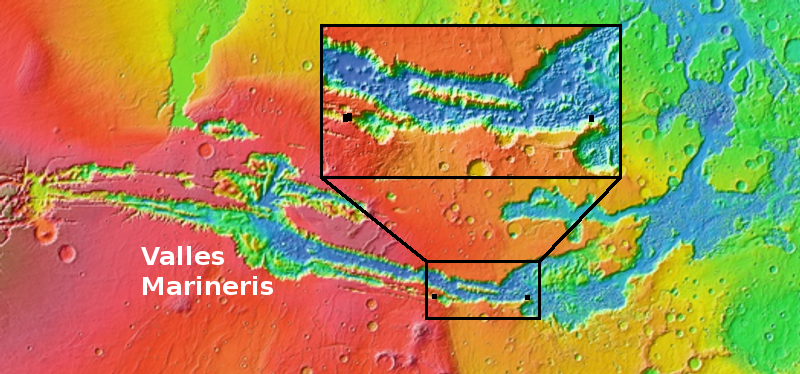Has work begun on a dedicated helicopter mission to Mars?

In my routine searches through the image archive for the high resolution camera on Mars Reconnaissance Orbiter, I recently came upon several images labeled “Candidate Mars Science Helicopter Traverse” that I at first thought referred to Ingenuity’s extended mission in Jezero Crater.
A closer look however revealed these photos have nothing to do with Ingenuity or Jezero Crater. Taken in November ’21, January ’22, and March ’22, the images instead cover parts of the south rim of Valles Marineris, the solar system’s largest canyon, and appear to be research for a future dedicated Mars helicopter mission. The overview map above shows the location of these photos by the black dots. Three locations have each been imaged twice to produce a stereoscopic view that can precisely measure the topography.
The photo to the right, cropped and reduced to post here, shows the easternmost image, taken November 3, 2021. Not only does it show ample flat areas, the picture captures an impressive avalanche flow coming down from that southern interior canyon slope.
All the images were requested by planetary scientist Edwin Kite of the University of Chicago. Though I tried several times to contact Dr. Kite to get more information, he unfortunately did not respond. It could be this work is still too preliminary and thus he does not wish to comment.
Nonetheless, the extent of the three sets of images give us a fair idea of the kind of missions Kite and others might be considering. From east to west the distance between the images is about four hundred miles, and covers a traverse of the southern interior slopes of Valles Marineris along that entire length. The photos look mostly at the base of the canyon’s slope, each showing clearly that a helicopter flying there would have plenty of landing spots.
Obviously this first dedicated Mars helicopter mission might not cover this entire distance. Right now these images could simply be the first tentative research on choosing potential landing areas. Regardless, it appears that at least one scientist has already concluded that Ingenuity has proven such helicopter missions make sense, and is beginning to target one of Mars’s most spectacular locations, Valles Marineris, for that mission.
On Christmas Eve 1968 three Americans became the first humans to visit another world. What they did to celebrate was unexpected and profound, and will be remembered throughout all human history. Genesis: the Story of Apollo 8, Robert Zimmerman's classic history of humanity's first journey to another world, tells that story, and it is now available as both an ebook and an audiobook, both with a foreword by Valerie Anders and a new introduction by Robert Zimmerman.
The print edition can be purchased at Amazon or from any other book seller. If you want an autographed copy the price is $60 for the hardback and $45 for the paperback, plus $8 shipping for each. Go here for purchasing details. The ebook is available everywhere for $5.99 (before discount) at amazon, or direct from my ebook publisher, ebookit. If you buy it from ebookit you don't support the big tech companies and the author gets a bigger cut much sooner.
The audiobook is also available at all these vendors, and is also free with a 30-day trial membership to Audible.
"Not simply about one mission, [Genesis] is also the history of America's quest for the moon... Zimmerman has done a masterful job of tying disparate events together into a solid account of one of America's greatest human triumphs."--San Antonio Express-News



Zubrin has been suggesting for some time that ingenuity could be replaced by much larger helicopters, potentially capable of carrying a person hundreds of miles. If starship lands soon, it could easily deliver something like this, plus establish a base to recharge it
Make it a quadcopter with wings to turn it into an eVTOL. Fixed wings are way better than rotary for range and speed.
A V-22-like air vehicle could allow the rapid exploration of Mars. While the atmosphere is indeed extremely thin, the gravity is only about 1/3 that of Earth. Stopped-rotor air vehicles might also fly at very high speeds, perhaps even becoming low-Mars-orbit vehicles, giving rapid access to the entire planet.
Such designs might compete quite favorably with surface vehicles that could face traction challenges in the sandy, rocky low-G environment, and thus be limited to relatively low speeds.
Dropping tiny rovers maybe.
Dragonfly is taking a dual quadcopter to Titan, where low gravity and a thick atmosphere make it the ideal destination for rotorcraft.
Why not send a blimp to Mars? The blimp would carry 4 robots. 2 at each end. After travels for an X number of hours, or days, it would drop 2 robots. These robots would be about the size of a model NASCAR. Also, why don’t we send smaller robots to Mars. These would be the size of a Hotwheels car. Send about 2 dozen of these. They would have the mind of a cockroach. They would be solar powered, but would also have a small battery. Might could make them cheap.